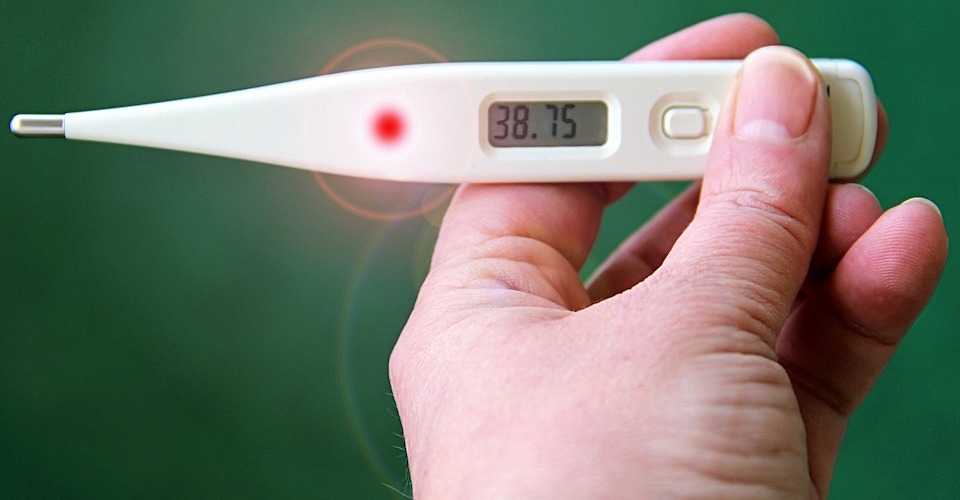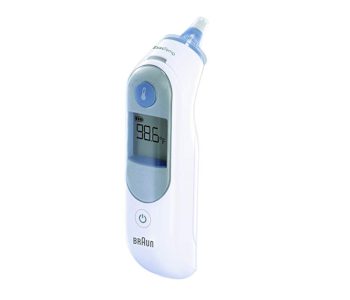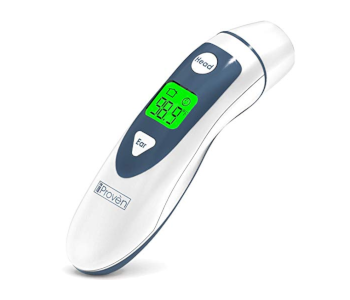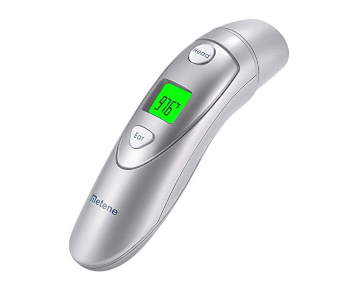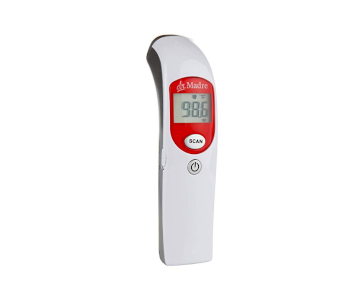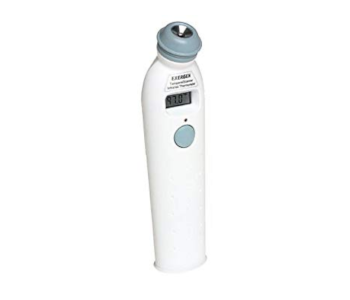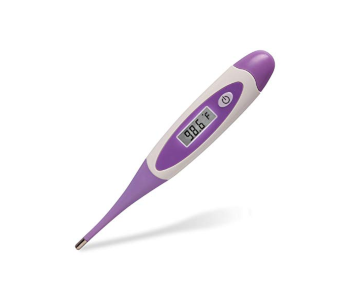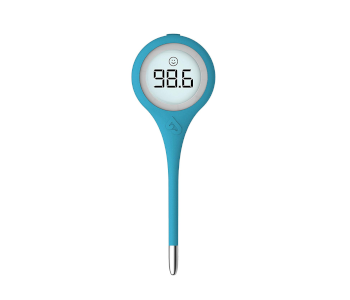Having a sick baby is no joking matter. A fever can be dangerous and scary for parents, and many frantic parents go to the emergency room in the middle of the night worried about their baby. A parent’s instinct is to take care of her child, but it’s hard to do without knowing your baby’s correct temperature. That’s why the best baby thermometer is a must for all parents.
When your baby is sick, there is no room for error. An incorrect thermometer can be the difference between being fine and needing to see a doctor as quickly as possible.
Quick Overview of the Best Baby Thermometers
| Brand | Type of Thermometer |
|---|---|
| Braun Ear Thermometer | Ear Thermometer |
| iProven Infrared Lens Thermometer | Ear & Forehead Thermometer |
| Innovo Non-Contact Digital Infrared Thermometer | Digital Infrared Thermometer |
| Vicks Baby Rectal Thermometer | Rectal Thermometer |
| Metene Medical Infrared Thermometer | Ear & Forehead Thermometer |
| Dr. Madre Digital Infrared Forehead Thermometer | Forehead Thermometer |
| Exergen Temporal Artery Thermometer | Temporal Artery Thermometer |
| Purple Safety Baby Digital Thermometer | Digital Thermometer |
| Kinsa Smart Stick | Digital Thermometer – Smartphone |
The Importance of a Baby Thermometer
You might think that a baby thermometer is just another extra baby item, but a thermometer is actually important. Purchasing a baby-specific thermometer is a good idea for several reasons.
- Regular oral thermometers don’t work for babies because they’re incapable of holding it under their tongue properly. Also, checking under the armpit is one of the least accurate ways to check temperature, especially for babies!
- Ear thermometers meant for older children and adults will be too large. You need one that is created for babies because they have smaller ear canals. Otherwise, your reading won’t be accurate.
- You should never use a mercury thermometer! If it happens to break and exposes your baby to mercury, it can be quite dangerous. Mercury is linked to neurological issues and other severe health problems.
Having a high fever is dangerous for infants, so getting a baby-specific thermometer ensures the reading is accurate. An accurate reading is necessary to decide if you need to seek medical attention.
The Types of Baby Thermometers
When you take a look at the thermometers at the store, you’ll notice several types of baby thermometers on the shelf. Options are great! Let’s take a look at the different types you might want to pick.
- Digital Thermometers
Digital thermometers have an electronic sensor on one side and a digital readout on the other end. You can use these a few ways – axillary (under the arm), orally, and rectally. ALWAYS label the thermometers that you use for oral or rectal since you don’t want to use it for both. That’s not sanitary!Most doctors don’t recommend that parents use digital thermometers. You aren’t able to get an accurate reading with an oral thermometer. These types aren’t meant to be used rectally, and they could cause injuries.
- Glass Thermometers
Perhaps you remember the glass thermometers from your childhood. Do you have memories of your mother holding a glass one under your tongue, and you watched the mercury rise up?
Nowadays, glass thermometers no longer use mercury because of the danger. If you do happen to use one with mercury, dispose of it properly. You don’t want your children to come in contact with the mercury! The current ones use a non-mercury substitute that works just the same.
Glass thermometers can be used orally, rectally, and axillary. Remember to label!
- Rectal Thermometers
The most accurate way to check your baby’s temperature is rectal. Yes, you may cringe a bit at the thought. We all do! It’s uncomfortable for everyone involved, but rectal temperatures are the most accurate. Using a rectal thermometer for your young infant is recommended.
These thermometers need to have a flexible tip to avoid injuring your baby. A wide base is also recommended because it prevents you from inserting it too far.
- Ear Thermometer
An ear thermometer is an easier way to take a baby’s temperature. These ones can quickly determine the temperature by sensing the infrared heat in the inside of the ear. There are some limitations when it comes to these.
- Ear wax build-up needs to be cleared out for an accurate reading.
- You have to insert correctly.
- An inappropriately sized tip won’t fit into the child’s ear canal won’t read the temperature right.
- The child must be three months old!
- Temporal Artery Thermometer
Parents love these “forehead thermometers” because they’re fast and easy. These are the newest type on the block, and they also tend to be the most expensive. You pay for convenience and accuracy!
You can use it properly on a newborn as well. Temporal artery thermometers measured the infrared heat that comes off the forehead. You don’t typically have to touch your baby, so they’re considered the safest and most convenient. Plus, they’re accurate. Chances are, if your baby is in the hospital, they’ll use a temporal artery thermometer.
Note that most experts do say that these thermometers are accurate for all ages. However, if you suspect a fever in your infant under three months old, double-check with a rectal thermometer.
- Oral Thermometer
Most doctors don’t recommend that parents take their baby’s temperature with an oral thermometer. Babies are incapable of holding a thermometer under his tongue to get an accurate reading.
Some parents like the pacifier thermometers because they’re a combination of oral and digital thermometers. On the front, there is a digital read-out. However, these are basically a gimmick, and doctors generally all agree that pacifier thermometers aren’t reliable for an accurate reading.
- Forehead Strip Thermometer
These aren’t the same thing as a temporal artery thermometer. The difference is that these are disposable plastic strips that you put on your baby’s forehead. Then, the temperature is displayed.
However, while these strips seem pretty cool, most experts say that they’re pretty inaccurate and shouldn’t be relied on for accurate readings.
How to Pick the Best Baby Thermometer
So, how do you pick the right baby thermometer for you? Here are some qualities to consider.
- Appropriate for Babies
First, you have to make sure the thermometer that you pick is appropriate for babies or the age of your child. You might want one that can be used for all ages, especially if you have multiple children. Some are best for only babies. Make sure you read the specifics and see if the manufacturer recommends it for an age range.
- Accuracy
Without a doubt, the most important factor to consider, aside from ensuring it’s right for your child’s age, is that the thermometer is accurate. Fevers can be dangerous at a high temperature, especially for infants, so you need to make sure you pick one that gives you a correct temperature. Look for ones that are recommended by medical experts.
That also means you want the thermometer to be consistent. Nothing is more frustrating than taking your baby’s temperature and then retaking it, only to find the temperature is totally different. Consistent means that each reading will be the same over and over again.
- Fahrenheit and Celsius
Does the thermometer read the unit that you prefer? Make sure it will give you the reading in the units you prefer. Otherwise, you’ll have to try to convert, and that can be frustrating.
- Speed of Reading
Babies aren’t known for their patience. Your baby doesn’t want to sit there forever while waiting for the display to read. Look for a thermometer that will take a few seconds to use. Holding a thermometer in your child’s ear for a minute won’t be fun for anyone.
- Ease of Use
Of course, who wants to use something that’s hard to understand. Do you want one with special features? A single button makes life easier, but others will save readings and display the history.
- Alert
A thermometer that makes an alert when the reading is done is great for middle of the night readings. You don’t know if the temperature on the reading is the old one or the new reading. You don’t want a loud alert either that might wake up your baby, so look at reviews and see what parents say.
- Light on Display
Doesn’t it seem as if babies always get sick in the middle of the night? It’s dark in the bedroom, and without a light on the display, it’ll be impossible to read the temperature.
The Best Baby Thermometers
1. Braun Ear Thermometer
One of the problems with ear thermometers is that it can be hard to get an accurate reading because of positioning. A wrong position means an inaccurate reading. Braun solves this problem by giving visual and audible signals that the thermometer tip is positioned correctly, so you know the reading is accurate.
Another awesome feature is that the tip warms up. It prevents the readings from being influenced by the outside temperature. Unlike other ear thermometers, the Braun has a flexible tip that makes it comfortable for your baby.
Each reading only takes a few seconds, so you don’t have to worry about struggling to hold your alligator baby down!
| The Pros |
|---|
| Positioning aid for accuracy |
| Fast reading |
| Celsius and Fahrenheit reading |
| Pre-warmed tip |
| The Cons |
|---|
| You have to buy disposable lens filters. |
| The screen doesn’t have a light. |
| No alert after reading is complete |
| No fever warning. |
2. iProven Infrared Lens Thermometer
The IProven thermometer can be used as an ear or forehead thermometer because it detects infrared heat. Readings taking between 1 and 3 seconds, so you don’t have to worry about disrupting your child too much.
Operating the thermometer is easy. All you have to do is push a button that indicates “ear” or “head.” You don’t have to worry about being confused. This thermometer has a beep that indicates the reading is finished, so you know when it’s finished. Another alarm will beep if a fever is detected.
The display has a backlight, so you can easily see the reading in the dark. It’s large and easy to read, great for caregivers!
| The Pros |
|---|
| It’s easy to use |
| A large display with a backlight |
| Has a fever indicator |
| Audible alert when finished reading the temperature |
| The Cons |
|---|
| Beep is loud |
| Expensive |
3. Innovo Non-Contact Digital Infrared Thermometer
Taking a baby’s temperature when they’re sleeping is a tricky task. You don’t want to risk waking a sick, sleeping baby, but monitoring a child’s fever is necessary for their health and safer. The Innovo Thermometer is the answer!
This infrared thermometer measures your child’s temperature, a bottle’s temperature, and anyone else’s temperature in one second without having to touch the person or the object. It’s perfect to use when you don’t want to disturb your child.
The display is large with a red fever indicator, and you can switch between silent mode or an audible noise that alerts you when the reading is done. The operation is easy; there is only one button.
| The Pros |
|---|
| Measures human and object temperatures |
| Silent mode |
| One-second reading |
| Has a carrying case for storage |
| The Cons |
|---|
| Might not be fully accurate |
| The display can be harder to read. |
4. Vicks Baby Rectal Thermometer
Rectal is the most accurate way to measure your baby’s temperature, but taking a rectal temperature has room for error. When done incorrectly, you can hurt your baby. The Vicks Baby Rectal Thermometer is designed with a baby’s body in mind. Vicks added a short probe that prevents parents from inserting it too far and accidentally hurting your baby.
It takes about 10 seconds to get a reading, which might feel like a long time, but it’s rather fast compared to old-school thermometers! Then, you can read the display easily with a backlight.
You might be concerned that getting a rectal temperature could be hard, but the Vicks Thermometer makes it quick easy!
| The Pros |
|---|
| Accurate reading |
| Fast reading |
| Short probe to stop injury |
| Backlight display |
| The Cons |
|---|
| No fever indicator |
| No audible alert when reading is finished |
| Only for rectal use! |
5. Metene Medical Infrared Thermometer
If you want a clinically tested thermometer, the Metene is a great choice. With the Metene, you don’t have to worry about the temperatures being inconsistent or inaccurate. This thermometer is FDA-approved and can be used to give parents a fast, quick temperature reading.
The Metene takes forehead and ear temperature measurements. It won’t disturb your child when he’s sleeping if you use the forehead option. All you have to do is swipe it across your baby’s forehead.
The display flashes green if your child’s temperature is in the safe zone. If he has a fever, the display turns bright red. All of the readings come fast within seconds.
| The Pros |
|---|
| FDA-Approved and backed by clinical testing |
| Takes both forehead and ear measurements |
| The display indicates a fever |
| The Cons |
|---|
| Ear measurements are best for older infants |
6. Dr. Madre Digital Infrared Forehead Thermometer
Forehead thermometers are loved by parents because they’re so easy to use. Dr. Madre is a great choice. You don’t even have to touch your child’s skin to use this. No contact is ideal for sleeping babies! All you have to do is hold the thermometer 2 to 4 inches away from your baby’s forehead to get an accurate reading.
The display is large and easy to read with a backlight. It has a talking mode that reads the results in either English or Spanish. Dr. Madre remembers the previous 12 readings and stores them in the history.
| The Pros |
|---|
| No contact needed |
| Large display with a backlight |
| Can read the results out loud |
| Remembers 12 previous recordings |
| Reads both Celsius and Fahrenheit |
| The Cons |
|---|
| Loud beep when turns on |
| No fever indicator |
7. Exergen Temporal Artery Thermometer
If you want a temporal artery thermometer, Exergen is loved by parents. With the swipe across the forehead, you’ll know your baby’s temperature. It takes seconds, so long as you remove the protective end cap which many parents forget to do!
Exergen lets out an audible beep to let you know that the thermometer is working. Some parents recommend that you take two or three readings and record the highest temperature to make sure your baby really does have a fever. Exergen is so sensitive that the temperature in your room (if its extreme) can throw off the results.
Readings take less than 20 seconds. It has an audible alert when the reading is finished.
| The Pros |
|---|
| Fast readings |
| Audible alert when finished |
| Easy to use |
| Backlight for display |
| The Cons |
|---|
| Pricey |
| Tricky to use |
| Need to take more than one reading |
8. Purple Safety Baby Digital Thermometer
Digital thermometers aren’t typically recommended for babies, but they’re cheap and great as a backup in case your batteries die. Purple Safety can be used rectally, under the armpit, or orally. It has a flexible tip that makes it comfortable to check your baby’s temperature rectally.
We had to include the Purple Safety because of its one of the most budget-friendly choices. It has nice options and takes less than 30 seconds to sound an alarm. The thermometer is waterproof, so it’s easy to clean. It does come with a case and an extra battery.
| The Pros |
|---|
| Flexible tip |
| Budget-friendly |
| An LCD display that’s bright |
| FDA-approved |
| The Cons |
|---|
| Reading time takes a long time. |
| Affected by outside temperatures |
9. Kinsa Smart Stick
Thermometers are getting high-tech now! Even though it might seem complicated, that’s far from the truth. All you have to do is plug the thermometer stick into your smartphone with the cable and take your child’s temperature with the thermometer. Kinsa can be used rectally, orally, or under the arm.
Kinsa has an app that lets you get the results within 10 seconds. The app has a fun bubble-popping game for your baby to play while waiting for the reading. You can record other symptoms and notes to share with your doctor later. Kinsa app provides recommendations based on the fever reading and your child’s age. Best of all? The Kinsa thermometer is powered by your phone so you never need batteries.
| The Pros |
|---|
| Easy to use |
| Powered by your phone |
| Provides health recommendations |
| Games to play on the app |
| Can be used rectally, orally, or axillary |
| The Cons |
|---|
| Needs a smartphone, so make sure the caregiver has a smartphone. |
How to Take a Baby’s Temperature
Always make sure you read your thermometer instruction booklet to ensure that you’re using it right.
Every thermometer is different, and some readings take longer than others. Make sure you read it before you panic! Here is how you take a baby’s temperature, but always read first!
- Rectal Thermometers: All you have to do is put the tip about a half inch to an inch into your baby’s rectum. That doesn’t mean your baby’s cheeks! Wait for a beep. You should use a dab of lubricant to help make sure it’s not uncomfortable for your baby.
- Axillary (Underarm) Thermometers: Taking an axillary temperature has a wide range of inaccuracy. To get the best reading, remove clothing at one arm and place the thermometer high into your baby’s armpit. Hold the arm in place until the thermometer indicates that the reading is over. Only skin should touch it!
- Temporal Artery Reading: These are so easy to use! Place the thermometer on the forehead, between his eyes, and press the button when your baby is still. Most don’t require that you touch your baby’s skin, but be sure to read the manual to find out.
- Oral Reading: For older children, place the thermometer under the tongue and have your child hold his mouth closed until the reading is complete. The tip of the thermometer should touch the tongue rather than the teeth or the open air.
- Ear Reading: Hold your child’s head and pull his ear up and backward to help open up the ear canal. Place the tip into the canal, but don’t shove it too hard. It should touch the ear evenly. Press the button and wait for the alert to let you know it took the reading. Look at the manual because some use disposable covers and others recommend cleaning the tip with alcohol swabs.
Final Thoughts
A baby with a fever is never a good thing, and a high temperature can be scary. Remember that an infant under three months old need to be seen if they have a temperature. Temperatures are particularly dangerous at that age. Keep close in contact with your child’s doctor and seek medical advice if you’re concerned. The best baby thermometer will provide you with the most accurate reading and help you decide what steps to take next.

